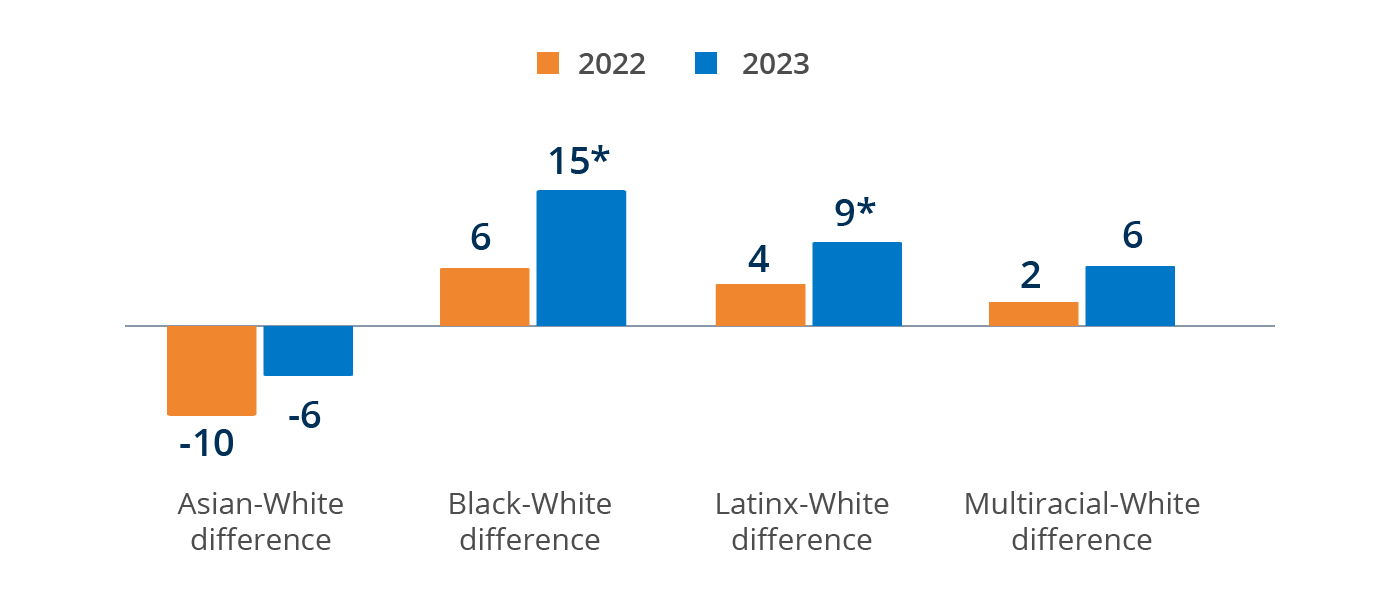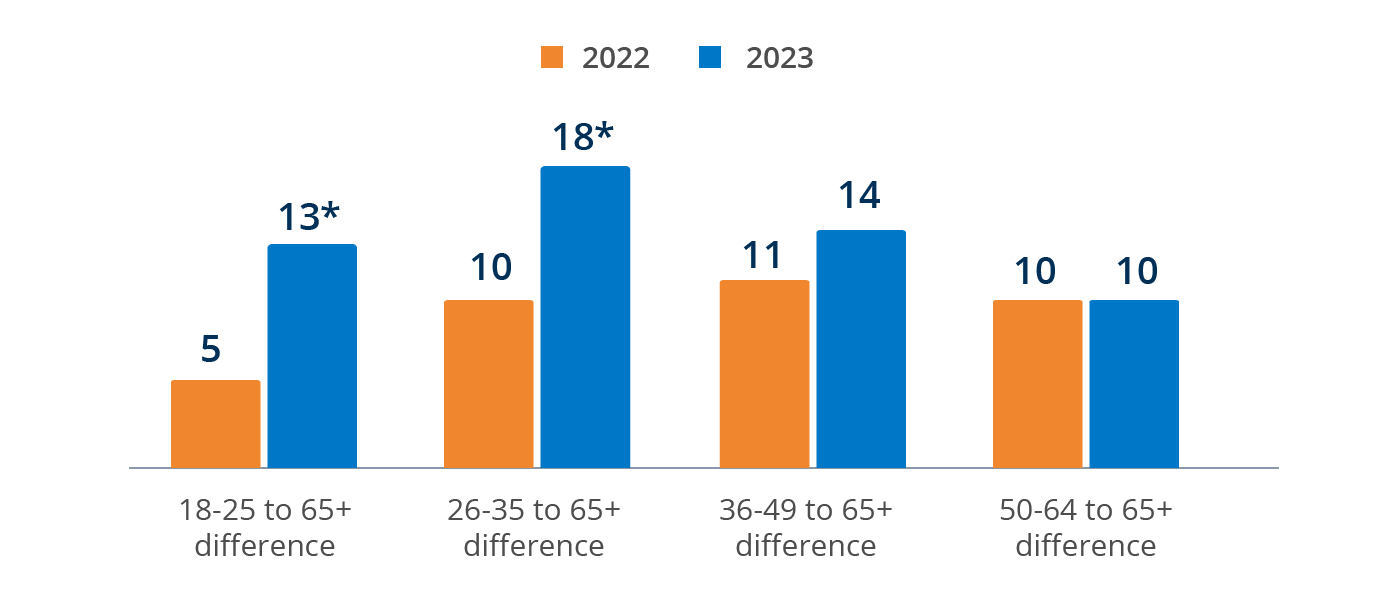Financial Health Pulse® 2023 U.S. Trends Report
By Kennan Cepa, Ph.D., Wanjira Chege, Necati Celik, Andrew Warren, Riya Patil
-
Program:
-
Category:

Overview
A Concerning Shift for U.S. Financial Health in 2023
After reaching a historic high in 2021, the 2023 U.S. Trends Report finds that the financial health of Americans has declined to pre-pandemic levels and some financial health disparities have widened over the past year. While the changes in financial health documented in last year’s report were driven by a declining share of Financially Healthy Americans, this year’s report reveals a new, concerning shift toward financial vulnerability – particularly among historically disadvantaged populations.
Between the spring of 2022 and the spring of 2023, the share of Financially Healthy Americans did not meaningfully change, but the share of Financially Vulnerable Americans increased to levels not seen since 2019.
Key Findings

The share of Financially Vulnerable Americans grew to 17% in 2023 from 15% in 2022.

Black, Latinx, and younger Americans disproportionately experienced an increase in financial vulnerability.

47% of unbanked households were Financially Vulnerable.

Workers at businesses with less than 100 employees were Financially Vulnerable twice as often as those working for businesses with 500 or more employees.
About the 2023 U.S. Trends Report
Since 2018, the U.S. Trends Report has used longitudinal probability-based surveys to document how financial health in the U.S. is changing over time and differs across consumers. The U.S. Trends Report is the annual report of the Financial Health PulseⓇ research initiative conducted by the Financial Health Network. The Financial Health PulseⓇ combines survey data with administrative data, with the goal of providing regular updates and actionable insights about the financial lives of Americans.
In 2023, we examined the financial health of newly added demographic and socioeconomic groups, which expands our analysis to over a dozen groups:
- Race and ethnicity
- Age
- Household composition
- LGBTQIA+ status
- Country of birth
- Geographic region
- Banking status
- Household income
- Net worth
- Housing status
- Entrepreneurship
- Employment status
- Employer size
- Self-rated overall and mental health
- Disability status
The percentage of Financially Vulnerable Americans returned to pre-pandemic levels.
Figure 1. Percentage of people by financial health tier (2018-23).

Note: * Statistically significant relative to 2023 (p < 0.05).
-
- 17% of Americans were Financially Vulnerable in 2023, an increase from 15% in 2022.
- The share of Americans who were Financially Healthy or Financially Coping did not meaningfully change over the last year.
Declines were observed across all four pillars of financial health: Spend, Save, Borrow, and Plan.
Figure 2. Percentage point change in positive responses for each financial health indicator (2022-23).

Note: * Statistically significant relative to 2022 (p < 0.05).
-
- With about half (49%) of Americans spending less than their incomes, this indicator is the lowest it’s been since we first began reporting on financial health in 2018.
- Three more indicators retreated to pre-pandemic levels: debt manageability, confidence in achieving long-term financial goals, and agreement that one’s household is planning ahead.
- Short-term savings also declined relative to 2022, but still remained above pre-pandemic levels.
- The three remaining indicators did not change from their 2022 levels.
Black and Latinx Americans disproportionately experienced an increase in financial vulnerability.
Figure 3. Percentage-point difference in share of Financially Vulnerable among racial and ethnic groups.

Note: * Statistically significant relative to 2022 (p < 0.05).
-
- Between 2022 and 2023, the share of Black and Latinx Americans who were Financially Vulnerable increased by 6 and 7 percentage points, respectively, while there was no meaningful increase in the share of Financially Vulnerable Asian, White, or Multiracial people.
- Financial health gaps between Black and White Americans and between Latinx and White Americans grew over the past year.
- Black and Latinx Americans experienced growing challenges around borrowing and financial planning.
Younger Americans disproportionately experienced an increase in financial vulnerability.
Figure 4. Percentage-point difference in share of Financially Vulnerable among age groups.

Note: * Statistically significant relative to 2022 (p < 0.05).
-
- Increases in the share of Financially Vulnerable Americans were concentrated among people between the ages of 18 and 35.
- Financial health gaps between the youngest and oldest Americans widened over the past year.
- Americans aged 65 and older face distinct financial challenges around savings, with 44% reporting a lack of confidence in reaching their long-term financial goals and 24% reporting that they did not have enough savings to cover three months of expenses.
This year’s report examines financial health by geographic region, household composition, and more.
Table 1. An increasing share of those living in southern states were Financially Vulnerable.
Percentage of people categorized by geographic region and financial health tier.
| Northeast | Midwest | South | West | |||||
| 2022 | 2023 | 2022 | 2023 | 2022 | 2023 | 2022 | 2023 | |
| Healthy | 32% | 33% | 34% | 32% | 27% | 27% | 32% | 31% |
| Coping | 55% | 53% | 51% | 52% | 57% | 54%* | 55% | 55% |
| Vulnerable | 13% | 14% | 15% | 16% | 16% | 20%* | 13% | 14% |
Note: * Statistically significant relative to 2022 (p < 0.05).
-
- One out of 5 (20%) Americans living in Southern states were Financially Vulnerable, a higher share than in any other region of the United States.
- Single women were more often Financially Vulnerable than single men or those who were married or partnered.
- In 2023, those born in the U.S. were more often Financially Vulnerable than those born outside of the U.S., though the considerable variation in the lived experiences of immigrants requires deeper exploration.
Large financial health gaps are tied to key financial characteristics.
Table 2. Unbanked and underbanked people were more frequently Financially Vulnerable.
Percentage of people categorized by banking status and financial health tier.
| Banked | Unbanked | Underbanked | ||||
| 2022 | 2023 | 2022 | 2023 | 2022 | 2023 | |
| Healthy | 36% | 35% | NA | NA | 14% | 14% |
| Coping | 54% | 54% | NA | NA | 59% | 54%* |
| Vulnerable | 10% | 11% | 47% | 47% | 27% | 32%* |
Note: * Statistically significant relative to 2022 (p < 0.05). NA reflects cells where the number of respondents was too small to report on with confidence.
-
- Despite recent declines in the share of unbanked households, our findings highlight how critically important it is to continue focusing on those without access to bank accounts. Nearly half (47%) of unbanked Americans were Financially Vulnerable, four times the share of those with a bank account (11%).
- Our new measure of net worth shows that almost half (48%) of those who reported being in debt were Financially Vulnerable, compared with just 6% of those who reported having positive net worth – a staggering 800% difference.
- This pattern was mirrored in two key drivers of wealth generation – homeownership and entrepreneurship. Three out of 10 (30%) renters were Financially Vulnerable in 2023, compared with just 9% of homeowners. Similarly, just 8% of entrepreneurs were Financially Vulnerable, compared with 15% of Americans who were not business owners.
Financial health varies depending on consumer experiences in the labor market.
Table 3. Unemployed people were more frequently Financially Vulnerable.
Percentage of people categorized by employment status and financial health tier (2023).
| Employed | Unemployed | Not in the labor force | |
| Healthy | 29%* | 7% | 36%* |
| Coping | 57% | 53% | 48%* |
| Vulnerable | 14%* | 40% | 15%* |
Note: * Statistically significant relative to those who were unemployed (p < 0.05).
-
- Two out of 5 (40%) unemployed Americans were Financially Vulnerable, compared with 14% of those who were employed and 15% of those who were not in the labor force.
- Those working at smaller businesses were more frequently Financially Vulnerable than those working for larger businesses. Workers at businesses with fewer than 100 employees were Financially Vulnerable twice as often as those working at businesses with 500 or more employees (18% versus 9%, respectively).
Financial health and health status are closely linked.
Table 4. Financial health decreases as self-rated mental and overall health declines.
| Self-rated mental health | Self-rated overall health | |||||
| Excellent or very good | Good | Fair or poor | Excellent or very good | Good | Fair or poor | |
| Healthy | 45% | 19%* | 7%* | 46% | 21%* | 12%* |
| Coping | 48% | 63%* | 53%* | 48% | 61%* | 51% |
| Vulnerable | 7% | 17%* | 40%* | 6% | 18%* | 37%* |
Note: * Statistically significant relative to “excellent” or “very good” self-rated health (p < 0.05).
-
- Those who reported that their overall health was fair or poor were Financially Vulnerable six times more often than those with good or excellent overall health. There was a similar pattern between financial health and mental health.
- People with disabilities were more often Financially Vulnerable than those without disabilities. Explore our recent report on the financial health of people with disabilities to learn more about the challenges this diverse community faces and how stakeholders across sectors can better support them.
Conclusion
A Call for Systems-Level Change
Our findings bring new urgency to the need to work toward financial health for all. The improvements in financial health observed in 2020 and 2021 have proven to be temporary. This return to pre-pandemic levels of financial health raises important questions about which aspects of our current economic situation have led to these declines and what we can do to reverse the trend. In addition, declining financial health among historically disadvantaged populations underscores the continued need to keep equity front of mind when developing products and policies to support financial health.
In line with the scope of the challenge posed by these findings, we intend this year’s report to be a call to action to a wide variety of audiences, including financial service providers, employers, policymakers, and researchers at academic institutions and think tanks. It will take the collective efforts of stakeholders across sectors to enact system-level solutions that effectively and swiftly respond to the rise in financial vulnerability. This year’s findings are a reminder that a focus on helping consumers become Financially Healthy should not divert attention from the circumstances of Americans who are Financially Vulnerable.
Financial Health Pulse® 2023 U.S. Trends Report
Explore the trends. Discover new insights. Build stronger strategies.
Methodology
The Financial Health Pulse survey was fielded between April 27, 2023, and June 11, 2023, to panelists of the University of Southern California’s Understanding America Study (UAS), which is a nationally representative, probability-based internet panel. The UAS identifies respondents for its panel via address-based sampling and the Financial Health Pulse survey is fielded online to all participants with the exception of those oversampled from Los Angeles County.1, 2
For additional methodological details and notes on terminology and data limitations, please download the full report.
- In 2018, the Financial Health Pulse survey was not fielded to the UAS panel’s Spanish-speaking respondents. In years since, the survey has been translated into Spanish and fielded to this group.
- A risk of using an internet-based panel is that not all respondents have access to the internet or a device with internet access and some may be less comfortable using computers. UAS offers a tablet with internet access to panelists to mitigate response bias from internet usage. In our 2023 survey, about 3% of respondents received a tablet and internet access from UAS, which is less than the percentage of households without internet access (10%) (see ACS 2021).
Acknowledgements
The Financial Health Network is grateful to the members of the Financial Health Pulse Advisory Council for their thoughtful reviews and strategic guidance.
The Financial Health Network is collaborating with USC’s Dornsife Center for Economic and Social Research to field the study to its online panel, the Understanding America Study. Study participants who agree to share their transactional and account data use Plaid’s data connectivity services to authorize their data for analysis. We thank them both for their collaboration.
The Financial Health Pulse is supported by the Citi Foundation, with additional funding from Principal Foundation. The findings, interpretations, and conclusions expressed in this piece are those of the Financial Health Network and do not necessarily represent those of our funders or partners.
Financial Health Pulse® 2023 U.S. Trends Report
Explore the trends. Discover new insights. Build stronger strategies.

